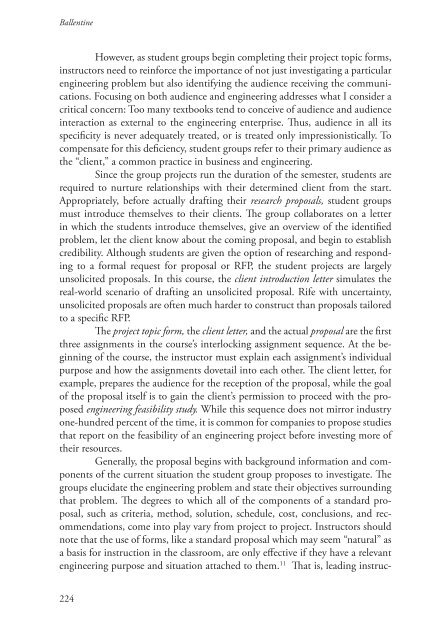Design Discourse- Composing and Revising Programs in Professional and Technical Writing, 2010a
Design Discourse- Composing and Revising Programs in Professional and Technical Writing, 2010a
Design Discourse- Composing and Revising Programs in Professional and Technical Writing, 2010a
You also want an ePaper? Increase the reach of your titles
YUMPU automatically turns print PDFs into web optimized ePapers that Google loves.
Ballent<strong>in</strong>e<br />
However, as student groups beg<strong>in</strong> complet<strong>in</strong>g their project topic forms,<br />
<strong>in</strong>structors need to re<strong>in</strong>force the importance of not just <strong>in</strong>vestigat<strong>in</strong>g a particular<br />
eng<strong>in</strong>eer<strong>in</strong>g problem but also identify<strong>in</strong>g the audience receiv<strong>in</strong>g the communications.<br />
Focus<strong>in</strong>g on both audience <strong>and</strong> eng<strong>in</strong>eer<strong>in</strong>g addresses what I consider a<br />
critical concern: Too many textbooks tend to conceive of audience <strong>and</strong> audience<br />
<strong>in</strong>teraction as external to the eng<strong>in</strong>eer<strong>in</strong>g enterprise. Thus, audience <strong>in</strong> all its<br />
specificity is never adequately treated, or is treated only impressionistically. To<br />
compensate for this deficiency, student groups refer to their primary audience as<br />
the “client,” a common practice <strong>in</strong> bus<strong>in</strong>ess <strong>and</strong> eng<strong>in</strong>eer<strong>in</strong>g.<br />
S<strong>in</strong>ce the group projects run the duration of the semester, students are<br />
required to nurture relationships with their determ<strong>in</strong>ed client from the start.<br />
Appropriately, before actually draft<strong>in</strong>g their research proposals, student groups<br />
must <strong>in</strong>troduce themselves to their clients. The group collaborates on a letter<br />
<strong>in</strong> which the students <strong>in</strong>troduce themselves, give an overview of the identified<br />
problem, let the client know about the com<strong>in</strong>g proposal, <strong>and</strong> beg<strong>in</strong> to establish<br />
credibility. Although students are given the option of research<strong>in</strong>g <strong>and</strong> respond<strong>in</strong>g<br />
to a formal request for proposal or RFP, the student projects are largely<br />
unsolicited proposals. In this course, the client <strong>in</strong>troduction letter simulates the<br />
real-world scenario of draft<strong>in</strong>g an unsolicited proposal. Rife with uncerta<strong>in</strong>ty,<br />
unsolicited proposals are often much harder to construct than proposals tailored<br />
to a specific RFP.<br />
The project topic form, the client letter, <strong>and</strong> the actual proposal are the first<br />
three assignments <strong>in</strong> the course’s <strong>in</strong>terlock<strong>in</strong>g assignment sequence. At the beg<strong>in</strong>n<strong>in</strong>g<br />
of the course, the <strong>in</strong>structor must expla<strong>in</strong> each assignment’s <strong>in</strong>dividual<br />
purpose <strong>and</strong> how the assignments dovetail <strong>in</strong>to each other. The client letter, for<br />
example, prepares the audience for the reception of the proposal, while the goal<br />
of the proposal itself is to ga<strong>in</strong> the client’s permission to proceed with the proposed<br />
eng<strong>in</strong>eer<strong>in</strong>g feasibility study. While this sequence does not mirror <strong>in</strong>dustry<br />
one-hundred percent of the time, it is common for companies to propose studies<br />
that report on the feasibility of an eng<strong>in</strong>eer<strong>in</strong>g project before <strong>in</strong>vest<strong>in</strong>g more of<br />
their resources.<br />
Generally, the proposal beg<strong>in</strong>s with background <strong>in</strong>formation <strong>and</strong> components<br />
of the current situation the student group proposes to <strong>in</strong>vestigate. The<br />
groups elucidate the eng<strong>in</strong>eer<strong>in</strong>g problem <strong>and</strong> state their objectives surround<strong>in</strong>g<br />
that problem. The degrees to which all of the components of a st<strong>and</strong>ard proposal,<br />
such as criteria, method, solution, schedule, cost, conclusions, <strong>and</strong> recommendations,<br />
come <strong>in</strong>to play vary from project to project. Instructors should<br />
note that the use of forms, like a st<strong>and</strong>ard proposal which may seem “natural” as<br />
a basis for <strong>in</strong>struction <strong>in</strong> the classroom, are only effective if they have a relevant<br />
eng<strong>in</strong>eer<strong>in</strong>g purpose <strong>and</strong> situation attached to them. 11 That is, lead<strong>in</strong>g <strong>in</strong>struc-<br />
224


















